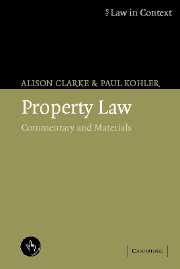Book contents
- Frontmatter
- Contents
- Preface
- Acknowledgments
- Table of cases
- Table of statutes
- Table of statutory instruments
- Table of treaties
- Table of EC legislation
- Part 1 The concept of property
- 1 Property law: the issues
- 2 What we mean by ‘property’
- 3 Justifications for property rights
- 4 Allocating property rights
- Part 2 The nature of proprietary interests
- Part 3 The acquisition and disposition of property interests
- Part 4 Proprietary relationships
- Bibliography
- Index
2 - What we mean by ‘property’
Published online by Cambridge University Press: 05 June 2012
- Frontmatter
- Contents
- Preface
- Acknowledgments
- Table of cases
- Table of statutes
- Table of statutory instruments
- Table of treaties
- Table of EC legislation
- Part 1 The concept of property
- 1 Property law: the issues
- 2 What we mean by ‘property’
- 3 Justifications for property rights
- 4 Allocating property rights
- Part 2 The nature of proprietary interests
- Part 3 The acquisition and disposition of property interests
- Part 4 Proprietary relationships
- Bibliography
- Index
Summary
Introduction
In Chapter 1 we provisionally described property law as being about the legal relationships we have with each other in respect of things. We now need to clarify and refine this.
Property as a relationship and as a thing
First, a terminological point. The term ‘property’ can be used to describe three different aspects of the relationship between people and things. Consider the statement ‘I have a right enforceable against you in respect of this car’. ‘Property’ can be used as an adjective to describe the nature of the right I have in the car (as in ‘I have a property right in the car, not just a personal right’). Equally, where you and I have a continuing relationship in respect of the car (perhaps I lent it to you, giving rise to the relationship of bailment between us), the term ‘property’ can be used, again as an adjective but this time to explain the nature of the relationship (as in ‘bailment is a property relationship’). Finally, ‘property’ can be used as a noun to denote the thing itself. So, to change the example, if I rent a flat from you, it is terminologically acceptable to say that both you and I have property rights in the flat, and that the lease relationship between us is a property relationship, and that the flat is the property in which each of us has rights.
The use of the term ‘property’ to denote the thing is sometimes frowned upon.
- Type
- Chapter
- Information
- Property LawCommentary and Materials, pp. 17 - 58Publisher: Cambridge University PressPrint publication year: 2005
- 1
- Cited by



